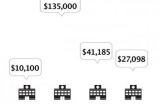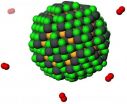(Press-News.org) Let's say you're buying a car. You have a wealth of data at your fingertips, from safety information to performance, to guide your decision.
The same is not as true in health care, especially if you're pricing procedures. A new study from the University of Iowa compared the cost of prostate cancer surgery at 100 hospitals throughout the United States. The quote for the procedure, the researchers found, varied from $10,100 to $135,000, a 13-fold range. (The average price was nearly $35,000, more than double the Medicare reimbursement.)
Only 10 of the hospitals that provided cost information divulged anesthesia and surgeon costs, key criteria to consider when pricing a surgical procedure. Moreover, just three hospitals provided a hard copy of the charges, further complicating a patient's ability to compare costs, the study found.
"Such variability in pricing can produce significant confusion for consumers who are accustomed to the rules of free-market economics, which equate higher fees with higher quality," write the UI researchers, in the journal Urology. "Unfortunately, in health care, this has not been found to be true."
Prostate disease is a major health concern in the U.S. It accounts for 28 percent of all new cancer diagnoses in men and nearly $12 billion in treatment costs, according to the American Cancer Society. About 138,000 prostate cancer surgeries are performed yearly, according to government figures. Yet despite the commonness of the disease and the frequency of surgeries, getting a reliable, accurate quote is hard to come by.
Part of that is due to the system itself. What hospitals charge for a procedure don't reflect the actual costs, says Bradley Erickson, assistant professor in urology at the UI and corresponding author on the study. Think of the hospital's quote as the opening salvo in a negotiation—a give-and-take primarily with the health insurance provider over how much the hospital gets reimbursed. In that scenario, the higher the quote, the more room there is to negotiate, and thus arguably the more the hospital could get reimbursed.
"These (hospital) charges don't mean anything," Erickson notes. "There's no weight behind them."
What that all means is the consumer is working with inflated figures, at best, which puts them "at a significant disadvantage," Erickson says. Even more, the researchers learned there is precious little information about how well hospitals perform prostate cancer surgeries, as they report outcome data mostly only to government agencies.
That lack of transparency is "a huge problem," Erickson says. "It doesn't really incentivize any place to improve outcomes, because no one is holding us individually accountable for it."
That could be worrisome to health-care consumers who may face higher deductibles under the Affordable Care Act, Erickson notes. "We're not ready for it (pricing transparency), because most hospitals can't tell you how much they charge," he says. "And the ones that do aren't based on reality."
Among the study's other findings:
70 of the 100 hospitals surveyed provided some pricing
Of that number, nearly half (33) said they'd discount the procedure, to as much as 80 percent, for pre-pay or promptly paying patients
Academic medical centers charged 52 percent more, on average, than nonacademic centers (The UI's estimate was $31,000, below the mean in the survey; the UI also offered a 25 percent discount for pre-paying patients.)
Hospitals in the northeast U.S. charged most (at $40,802 on average), while hospitals in the South charged the least ($30,305 on average)
Hospitals in the Midwest were the most likely to provide estimates and to offer discounts
There was little price difference at centers either when city population is factored or rankings as compiled by U.S. News and World Report
The prostate-cancer surgery costs survey follows a UI study, published last year in JAMA Internal Medicine, which found hip replacement costs at hospitals nationwide ranged more than ten-fold, from $11,100 to $125,798. The reason, those researchers found, are largely due to the lack of transparency and knowledge how hospitals set their prices.
It also corroborates findings from the Centers for Medicare and Medicaid Services, which reported wide price differences for a variety of medical procedures across the U.S.
In a separate editorial comment in the journal, the authors, from the University of Montreal and Harvard Medical School, write: "The discrepancy in pricing highlights the substantial incongruity between the actual costs of a surgical procedure and the hospital charges. It would be highly implausible that the exact same procedure is 13 times more expensive to deliver at one hospital relative to another."
INFORMATION:
Scott Pate, a UI medical student now at the University of Kansas, is the first author on the study, first published in March. Contributing authors include Matthew Uhlman, Jaime Rosenthal, and Peter Cram.
There was no outside funding for the study.
Surgery prices are elusive
University of Iowa study finds 13-fold price difference among U.S. hospitals for prostate cancer surgery
2014-06-09
ELSE PRESS RELEASES FROM THIS DATE:
New class of nanoparticle brings cheaper, lighter solar cells outdoors
2014-06-09
TORONTO, ON — Think those flat, glassy solar panels on your neighbour's roof are the pinnacle of solar technology? Think again.
Researchers in the University of Toronto's Edward S. Rogers Sr. Department of Electrical & Computer Engineering have designed and tested a new class of solar-sensitive nanoparticle that outshines the current state of the art employing this new class of technology.
This new form of solid, stable light-sensitive nanoparticles, called colloidal quantum dots, could lead to cheaper and more flexible solar cells, as well as better gas sensors, infrared ...
With distance comes greater wisdom, research finds
2014-06-09
If you're faced with a troubling personal dilemma, such as a cheating spouse, you are more likely to think wisely about it if you consider it as an observer would, says a study led by a professor at the University of Waterloo.
Professor Igor Grossmann, of Waterloo, and Professor Ethan Kross from the University of Michigan, asked study participants to reflect on a relationship conflict of their own or someone else's, such as a spouse's infidelity with a close friend, and think about the conflict in the first and third person. The findings will appear in an upcoming issue ...
Online marketing schemes can still lure in customers
2014-06-09
Despite warnings and legislation, online consumers may still be susceptible to post-transaction marketing schemes, according to Penn State researchers.
At least 40 percent of consumers who made an online purchase in a study bought an additional product, even though it offered no extra value, said Jens Grossklags, assistant professor of information sciences and technology.
"The focus of this study was to determine the likelihood that a consumer would accept an offer after they had already made a purchase," said Grossklags. "What stood out was the vast number of people ...
Seeing how a lithium-ion battery works
2014-06-09
CAMBRIDGE, Mass-- New observations by researchers at MIT have revealed the inner workings of a type of electrode widely used in lithium-ion batteries. The new findings explain the unexpectedly high power and long cycle life of such batteries, the researchers say.
The findings appear in a paper in the journal Nano Letters co-authored by MIT postdoc Jun Jie Niu, research scientist Akihiro Kushima, professors Yet-Ming Chiang and Ju Li, and three others.
The electrode material studied, lithium iron phosphate (LiFePO4), is considered an especially promising material for ...
Science and technology advances in microbial forensics needed to better prepare
2014-06-09
WASHINGTON – Much as human DNA can be used as evidence in criminal trials, genetic information about microorganisms can be analyzed to identify pathogens or other biological agents in the event of a suspicious disease outbreak. The tools and methods used to investigate such outbreaks belong to an emerging discipline known as microbial forensics, but the field faces substantial scientific and technical challenges, says a new report from the National Research Council. The report offers an initial set of research priorities for advancing the capabilities needed to make microbial ...
Specific protein may help beta cells survive in type 1 diabetes
2014-06-09
In the healthy pancreas of someone without type 1 diabetes (T1D), the hormone insulin (essential for turning food into energy) is produced, stored, and released in a normal "factory-like" process within pancreatic beta cells in response to glucose in the diet. Early in the course of T1D, however, excessive or pathologic stress in beta cells compromises their ability to properly secrete insulin, triggering a cascade of events ultimately contributing to the beta cell death. Over the past several years, JDRF-funded researchers have found evidence that beta cell stress may ...
55-year old dark side of the moon mystery solved
2014-06-09
The Man in the Moon appeared when meteoroids struck the Earth-facing side of the moon creating large flat seas of basalt that we see as dark areas called maria. But no "face" exists on farside of the moon and now, Penn State astrophysicists think they know why.
"I remember the first time I saw a globe of the moon as a boy, being struck by how different the farside looks," said Jason Wright, assistant professor of astrophysics. "It was all mountains and craters. Where were the maria? It turns out it's been a mystery since the fifties."
This mystery is called the Lunar ...
Tangled path of Alzheimer's-linked brain cells mapped in mice
2014-06-09
By studying laboratory mice, scientists at The Johns Hopkins University have succeeded in plotting the labyrinthine paths of some of the largest nerve cells in the mammalian brain: cholinergic neurons, the first cells to degenerate in people with Alzheimer's disease.
"For us, this was like scaling Mount Everest," says Jeremy Nathans, Ph.D., professor of molecular biology and genetics, neuroscience, and ophthalmology at the Johns Hopkins University School of Medicine. "This work reveals the amazing challenges that cholinergic neurons face every day. Each of these cells ...
NASA's TRMM satellite analyzes Mexico's soaking tropical rains
2014-06-09
VIDEO:
This movie of NOAA's GOES-East satellite imagery shows the movement of System 90L over land and dissipating between June 6 and June 7 at 2000 UTC (4 p.m. EDT)....
Click here for more information.
The movement of tropical storm Boris into southern Mexico and a nearly stationary low pressure system in the southern Gulf of Mexico caused heavy rainfall in that area. NASA and the Japan Aerospace Exploration Agency's Tropical Rainfall Measuring Mission satellite known as TRMM ...
A new methodology developed to monitor traffic flow
2014-06-09
"If we know not only the volume of the traffic but also the way in which the flow is taking place, we can detect when the traffic is undergoing a significant change. This information can be used, for example, when decisions are taken about signs (traffic lights, directions, etc.), road capacity, and other aspects," explained Fermín Mallor, Prof of the Department of Statistics and Operational Research.
What is new about this research is that it applies the so-called curve statistics to the specific problem of traffic control or monitoring. The use of the methodology is ...
LAST 30 PRESS RELEASES:
UMass Amherst chemists develop unique tool for studying RNA
Disappointment alters brain chemistry and behavior
A built-in odometer: new study reveals how the brain measures distance
Stress-related brain signals drive risk of cardiovascular disease in people with depression and anxiety
New details on role of fat transport molecules in Alzheimer’s onset
Study illuminates how an antiviral defense mechanism may lead to Alzheimer’s disease
Spot the males: New gene-editing method could transform mosquito control
AI learns to build simple equations for complex systems
NAU team releases 13 years of detailed U.S. CO2 emissions data
Unveiling how sodium-ion batteries can charge faster than lithium-ion ones
How do childcare tax credits affect children’s long-term health?
Can an electronic nose detect indoor mold?
Do natural disasters have long-term impacts on mortality in older adults?
Modification improves sodium‐ion batteries as an alternative to lithium-ion batteries
Parasports provide a range of benefits for people with cerebral palsy
How does grandparental care affect children’s health?
Why are there so many Nordic mediators?
Young shark species more vulnerable to extinction
Mobile fetal heart monitoring linked to fewer newborn deaths in Tanzania
Bluey’s dad offered professorial chair in archaeology at Griffith University
Beyond small data limitations: Transfer learning-enabled framework for predicting mechanical properties of aluminum matrix composites
Unveiling non-thermal catalytic origin of direct current-promoted catalysis for energy-efficient transformation of greenhouse gases to valuable chemicals
Chronic breathlessness emerging as a hidden strain on hospitals
Paleontologists find first fossil bee nests made inside fossil bones
These fossils were the perfect home for ancient baby bees
Not everyone reads the room the same. A new study examines why.
New research identifies linked energy, immune and vascular changes in ME/CFS
Concurrent frailty + depression likely boost dementia risk in older people
Living in substandard housing linked to kids’ missed schooling and poor grades
Little awareness of medical + psychological complexities of steroid cream withdrawal
[Press-News.org] Surgery prices are elusiveUniversity of Iowa study finds 13-fold price difference among U.S. hospitals for prostate cancer surgery




